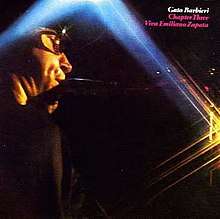Chapter Three: Viva Emiliano Zapata
Chapter Three: Viva Emiliano Zapata is an album by Argentinian saxophonist and composer Gato Barbieri released on the Impulse! label.[2]
| Chapter Three: Viva Emiliano Zapata | ||||
|---|---|---|---|---|
 | ||||
| Studio album by | ||||
| Released | September 1974[1] | |||
| Recorded | June 25–26, 1974 Generation Sound Studios, New York | |||
| Genre | Jazz | |||
| Length | 34:54 | |||
| Label | Impulse! ASD-9279 | |||
| Producer | Ed Michel | |||
| Gato Barbieri chronology | ||||
| ||||
Reception
The Allmusic review by Thom Jurek awarded the album 4 stars calling it "a stellar recording, and of the four chapters in the series, the one most accessible to most jazz fans".[3]
| Review scores | |
|---|---|
| Source | Rating |
| Allmusic | |
| The Rolling Stone Jazz Record Guide | |
Track listing
- All compositions by Gato Barbieri except as indicated
- "Milonga Triste" (Homero Manzi, Sebastian Piana) - 5:00
- "Lluvia Azul" - 7:44
- "El Sublime" - 5:51
- "La Padrida" - 4:46
- "Cuando Vuelva a Tu Lado (What a Difference a Day Makes)" (Stanley Adams, María Grever) - 5:27
- "Viva Emiliano Zapata" - 6:06
The album was recorded on June 25 (tracks 1, 4) and June 26 (tracks 2-3, 5), 1974.
Personnel
- Gato Barbieri - tenor saxophone
- Randy Brecker, Bob McCoy, Victor Paz - trumpet, flugelhorn
- Buddy Morrow - trombone
- Alan Raph - bass trombone
- Ray Alonge, Jim Buffington - French horn
- Howard Johnson - tuba, flugelhorn, bass clarinet, baritone saxophone
- Seldon Powell - piccolo, flute, alto flute, alto saxophone, baritone saxophone
- Eddie Martinez - piano, electric piano
- Paul Metzke - electric guitar
- George Davis - electric guitar, acoustic guitar
- Ron Carter - bass, electric bass
- Grady Tate - drums
- Ray Armando, Luis Mangual, Ray Mantilla, Portinho - Latin percussion
- Chico O'Farrill - arranger, conductor
gollark: Can't say about the first one, but I think there are cheap 433 MHz transceiver things for raspberry pis available. They can do WiFi and Bluetooth themselves, so you could maybe just use that.
gollark: Maybe it changes the settings on one of the video outputs in some odd way.
gollark: I thought they mostly used SAS disks?
gollark: We didn't do any mathy stuff beyond, what, square roots?
gollark: We did magnets a bit, but like most of the GCSE stuff it was very lacking in maths and anything and more just, er, qualitative stuff.
References
- Billboard Sept 28, 1974
- Impulse! Records discography accessed January 9, 2012
- Jurek, T. Allmusic Review accessed January 9, 2012
- Swenson, J., ed. (1985). The Rolling Stone Jazz Record Guide. USA: Random House/Rolling Stone. p. 19. ISBN 0-394-72643-X.
This article is issued from Wikipedia. The text is licensed under Creative Commons - Attribution - Sharealike. Additional terms may apply for the media files.